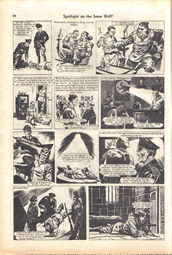


Writer:- Not known. Artist:- Keith Shone. (click on Keith's name to view some of the artist's latest landscape art).
This is an exciting action strip, well scripted and with artwork byKeith Shone visually exciting as well. My only complaint about the story is that there is no explanation as to why Ames was called the Snow Wolf. The only clue was provided in one of the later episodes when the team were battling their way through a blizzard and one of the soldiers briefly explained that they called him Snow Wolf because he could find his way no matter how bad the weather was.
Norway during World War Two - brief military historical facts.
3rd September 1939 - Great Britain declares war on Nazi Germany. Norway proclaims herself neutral.
8th April 1940 - Many Norwegian fjords are mined by British warships during the night to prevent Swedish iron ore being exported to Germany. The Norwegian Government protests to Britain.
9th April 1940 Nazi Germany swiftly invades Norway via Denmark, due to months of forward planning.
15th/16th April 1940 British and French troops land at the Lofoten Islands, then on the 16th at Namsos, north of Trondheim, Norway.
10th May 1940 - Great Britain and France sends troops to the northern Norwegian port of Narvik and occupies it from 10th May to 8th June 1940. Two naval battles were fought here as well.
May 1940 German forces capture the south of the country, but in the north Norwegian, Polish, Britsh and French forces drive the Germans back to the Swedish border. A decision by the British and French is made to abandon the port and retreat from Norway. The German Navy lost so many ships, that only three cruisers and four destroyers were operational. Germany therefore did not have enough ships to protect any German invansion force of Britain. The naval campaign in Norway probably saved Britain from being invaded.
Early June 1940 - Norway surrenders.
7th June 1940 The Norwegian King Haakon VII leaves Norway for England and sets up a Government-in-exile in London, Britain.
Norwegian armed forces that escaped from Norway served with distinction with the Allied forces. For example, the Norwegian destroyer Stord being involved in the hunting and sinking of the German battleship Scharnorst and the sailors of the Norwegian merchant fleet which carried vital supplies to all areanas of the Second World War.
19th November 1942 Two gliders carrying thirty-four British Royal Engineer Commandoes crashes in Norway en route to destroy the heavy water plant at Vemark in Telemark county. Those that survived were captured, questioned, tortured and shot, even though the soldiers were all in uniform.
27th February 1943 A second attempt to destroy the plant was made by ten British S.O.E. (Special Operations Executive) trained Norwegians. (The S.O.E.'s directive was to 'set Europe ablaze' by organising resistance in Europe). Operation Gunnerside was carried out by the Norwegians dressed as British Commandoes, (to reduce reprisals against the local civilan population), on the Heavy water plant, at Vemark in Telemark county. The plant produced the chemical liquid which is one element required for the production of an atomic bomb. Even though the the plant was damaged, it was quickly repaired.
'Heavy water or 'Deuterium oxide', to give it its scientific name, is excellent 'braking' medium, causing chemical and biographical processes to happen at a far slower rate than in ordinary water.' (Mears, 2003).
20th February 1944 The Germans made plans to move the remaining heavy water stock and critical components to Germany, via train and ferry. The Norwegian resistence was aware of this plan and planted a bomb on board the ferry carrying the railway trucks across Lake Tinnsjo. A number of Norwegian civilians on the ferry died in the explosion.7th May 1945 German forces surrendered in Norway.
7th June 1945 King Haakon VII returns to Norway.
Every year Norway sends the United Kingdom a large Norwegian spruce tree (which is erected in Trafalgar Square), as a gift of thanks to Britain for the country's help during World War Two. Strong links still unite these two countries.
Sources referred to for the above information
BBC Radio 4 Telemark raid programme. Norway timeline. BBC History - Norway. Mears, Raymond The Real Heores of Telemark: The true story of the Secret Misson to stop Hilter's Atomic Bomb.- Hodder & Stoughton Ltd, 2003.-Bibliography
Further reading. (This is only a short list of books that I have read and can recommend, there are of course many other excellent works available).
OLSEN, Oluf Reed Two Eggs on my Plate.- Allen and Unwin, 1952.- ISBN 0049400185. (This is the tale of a Norwegian resistance leader operating in Norway. An enthralling read).
HOWARTH, David The Shetland Bus : WW2 Epic of Escape, survival and adventure. The Lyons Press, 2002.- ISBN 1585742880.- (The amazing stories of young Norwegian merchant sailors sailing their trawlers between the Shetland Islands and the coast of Norway during the stormy, dangerous seas and dark winters carrying military equipment and secret agents).
GALLAGHER, Thomas Assault in Norway: The true story of the Telemark Raid.- Macdonald, 1975.- ISBN 0356082962.- (The raid that destroyed the German Heavy water plant).
The episode below is from The Hornet issue 157. Artwork by Keith Shone. |
 |
 |
 |
 |
 |